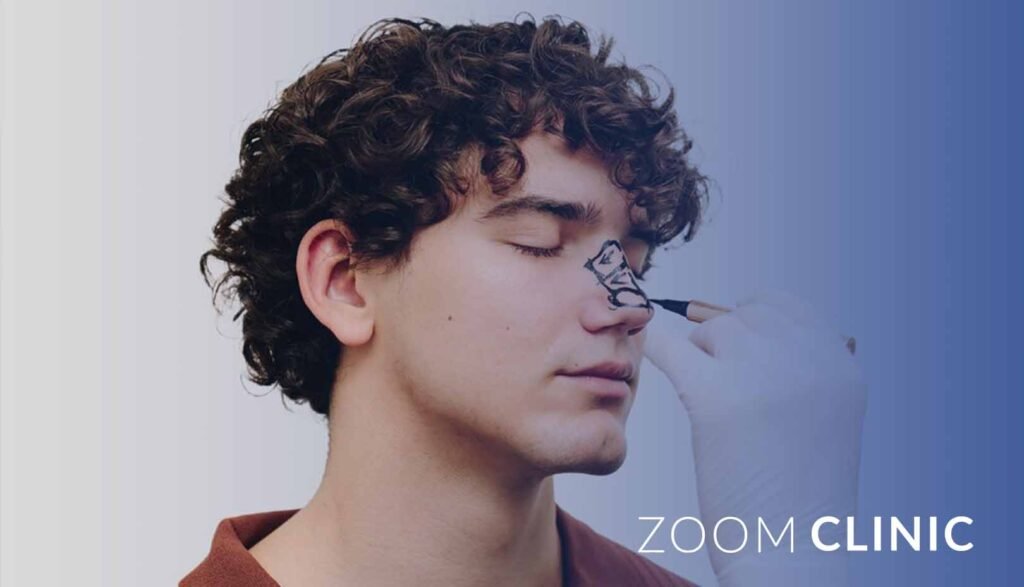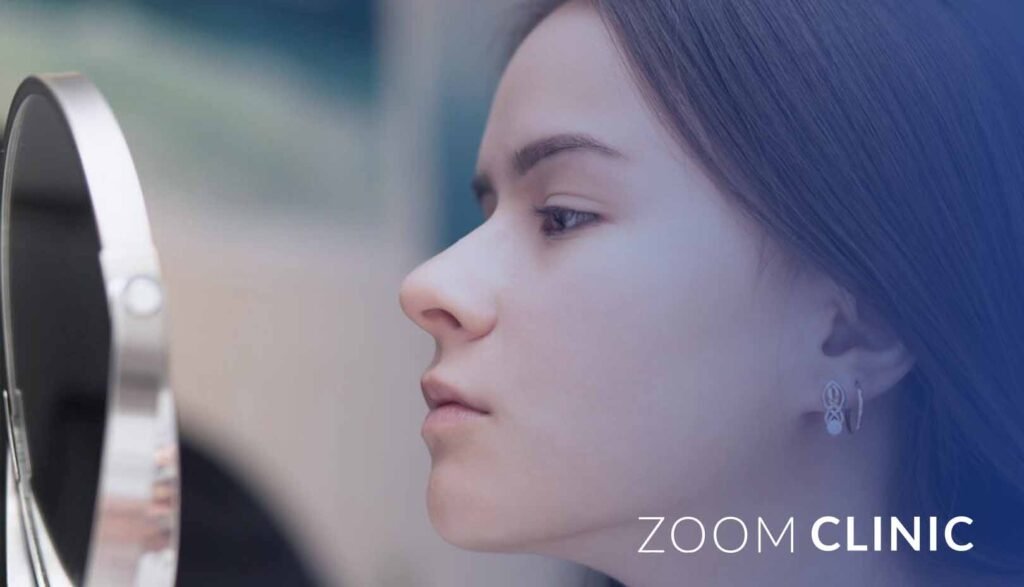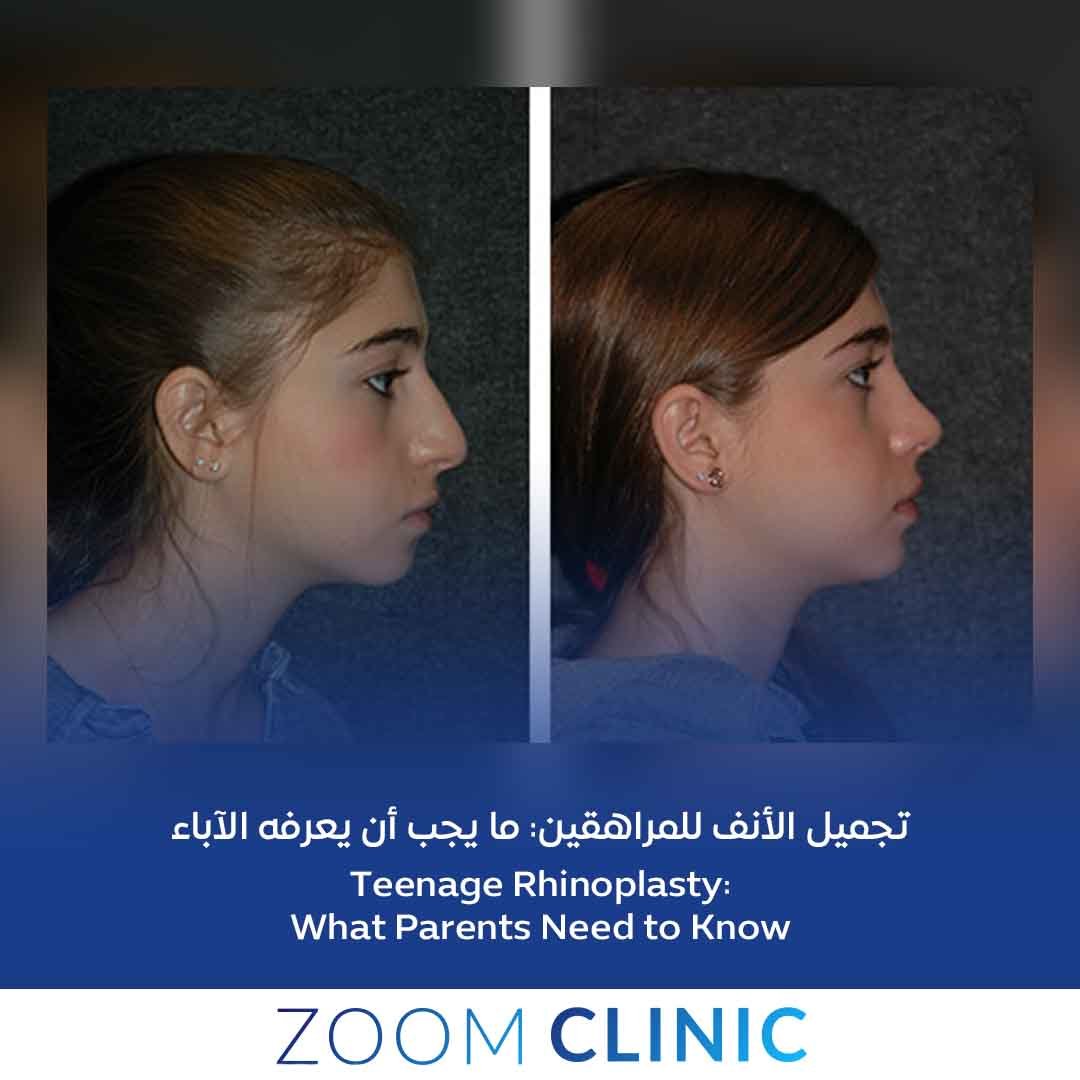Rhinoplasty, or nose surgery, has become one of teenagers’ most common cosmetic procedures.
Teen rhinoplasty, also known as teen nose surgery, is a specialized procedure tailored to address cosmetic and functional concerns in teenage patients.
Rhinoplasty can be a transformative experience for teens who are self-conscious about their noses or have functional issues such as a deviated septum.
However, pursuing teenage rhinoplasty involves essential considerations, particularly for parents.
This guide addresses the key aspects of rhinoplasty for teens, including age requirements, emotional readiness, and the role of parental guidance.
Table of Content
Understanding Teenage Rhinoplasty
Teenage rhinoplasty, a nose job, is a surgical procedure that improves the nose’s shape, size, and function. It has gained popularity among teenagers who are dissatisfied with their nasal appearance and seek to enhance their facial harmony.
Rhinoplasty can address various concerns, such as a drooping nasal tip, a bump on the bridge, or nostrils that are either too large or too small. By reshaping the nose, teenage rhinoplasty can significantly boost a young person’s self-esteem and overall confidence.
Age Requirements for Teenage Rhinoplasty

One of the primary factors in determining a teen’s readiness for rhinoplasty surgery is their physical development.
The nasal bones and cartilage must have reached maturity to ensure long-lasting results from the procedure. For most teenage patients, this milestone occurs:
- For girls: Around 15 to 16 years old.
- For boys: Around 16 to 17 years old.
It is essential to consult with an experienced plastic surgeon who can assess whether a teen’s facial development is complete.
Performing rhinoplasty before full development can lead to complications, and teens must be physically mature to undergo rhinoplasty safely.
Emotional Readiness for Rhinoplasty
In addition to physical maturity, emotional readiness is a critical consideration. Rhinoplasty is a significant decision that requires teenagers to have realistic expectations and a mature understanding of the procedure.
Emotional readiness is essential to facial plastic surgery, as the results are apparent and can significantly impact a teenager’s self-esteem. Here are some questions to evaluate emotional readiness:
- Is the teenager motivated by personal reasons rather than external pressures?
- Do they have realistic expectations about the results?
- Are they aware of the recovery process and potential risks?
Parents should encourage open and honest discussions about their teenager’s motivations for undergoing rhinoplasty and ensure that the decision aligns with their overall well-being.
Candidacy for Plastic Surgery
To be considered a suitable candidate for teenage rhinoplasty, the patient must meet specific criteria. First, the patient should be at least 15 years old, as this is typically when the nose reaches its adult size.
A consultation with a board-certified plastic surgeon is crucial to assess the patient’s nasal shape and overall facial structure.
Additionally, candidates must have realistic expectations about the procedure’s outcome and be physically and emotionally healthy. Ensuring these criteria are met helps achieve satisfactory and lasting results from the surgery.
Choosing the Right Plastic Surgeon

Selecting qualified and experienced plastic surgeons is essential for a successful rhinoplasty procedure. Look for a board-certified facial plastic surgeon with experience performing rhinoplasty on young patients.
During the initial consultation, the surgeon will:
- Evaluate the teen’s facial features and nasal shape.
- Discuss whether the patient is a good candidate for rhinoplasty.
- Explain the surgical techniques, such as open or closed rhinoplasty.
- Outline the recovery process and set realistic expectations.
A private consultation allows the teenager and parents to address concerns and comprehensively understand the procedure.
The Rhinoplasty Procedure
The rhinoplasty procedure generally takes 1-2 hours and is performed under general anesthesia. Depending on the patient’s specific needs, the surgeon will make incisions either inside the nose or on the columella, the tissue that separates the nostrils.
The surgeon will then reshape the bone and cartilage to achieve the desired nasal shape and size. This may involve reducing the size of the nose, straightening the bridge, or reshaping the tip. The goal is to create a nose in harmony with the rest of the facial features, enhancing appearance and function.
Benefits of Rhinoplasty for Teens
Teen rhinoplasty can provide both cosmetic and functional benefits for young patients, including:
- Improved Appearance: Enhancing facial harmony by reshaping the nasal tip, correcting a drooping nasal tip, or addressing other aesthetic concerns.
- Boosted Self-Esteem: Helping teens feel more confident and less self-conscious about appearance.
- Functional Improvements: Correcting breathing issues caused by a deviated septum or other structural abnormalities.
Risks and Considerations
Like any surgical procedure, teenage rhinoplasty carries potential risks, including:
- Swelling and bruising during the first week of recovery.
- Infection or complications related to general anesthesia.
- Prolonged healing process for certain patients.
Unlike primary rhinoplasty, performed on adults, teen rhinoplasty requires careful consideration of the patient’s developmental stage to ensure safe and effective results.
Parents should work closely with the surgeon to understand these risks and ensure proper care during the recovery period.
Cost and Insurance Considerations
The cost of teenage rhinoplasty can vary widely based on factors such as location, the surgeon’s expertise, and the complexity of the procedure. On average, it ranges from $5,000 to $15,000.
Insurance may cover some or all expenses if the procedure is deemed medically necessary to correct a deviated septum or improve breathing.
However, if the procedure is purely cosmetic, insurance will unlikely cover the expenses.
It is essential to consult with a board-certified plastic surgeon to discuss the costs and explore potential insurance options, ensuring that all financial aspects are clearly understood before proceeding with the surgery.
Preparing for Teen Rhinoplasty Surgery

Preparation plays a key role in ensuring a smooth rhinoplasty procedure and recovery.
In addition to rhinoplasty, many board-certified surgeons specialize in neck surgery, providing comprehensive care and expertise in facial procedures. Parents and teens should:
- Follow Pre-Operative Instructions: Avoid certain medications and maintain a healthy lifestyle to minimize risks.
- Plan for Recovery Time: Ensure the teen has time off from school and avoids contact sports or strenuous activities during healing.
- Set Realistic Expectations: Understand that results may take several months to appear as swelling subsides fully.
Post-Surgery Recovery Tips
The healing process requires patience and care. Key recovery tips include:
- Keeping the head elevated to reduce swelling.
- Following the surgeon’s guidelines for cleaning the incision site.
- Attending follow-up appointments to monitor progress.
- Avoid any pressure on the nose to ensure proper healing.
Helping Teens Make an Informed Decision
Parents play a vital role in guiding their teenagers through the decision-making process.
Open communication, thorough research, and support from an experienced plastic surgeon can help ensure the procedure is a positive and empowering experience.
Understanding the specifics of teen rhinoplasty surgery, including the benefits and risks, is crucial for making an informed decision. Encourage your teen to ask questions, explore their motivations, and understand both the advantages and limitations of rhinoplasty.
Conclusion
Rhinoplasty can be life-changing for teens when approached carefully and with professional guidance.
Parents can help their teenagers make informed decisions by assessing their physical and emotional readiness, consulting an experienced surgeon, and setting realistic expectations.
Whether addressing functional issues or enhancing appearance, teenage rhinoplasty should always prioritize the young patient’s health, safety, and confidence.
Get the special offer today from Zoom Clinic
Read Also:
Choosing the Right Rhinoplasty Surgeon
Celebrity Rhinoplasty Transformations
Rhinoplasty for Breathing Problems
Frequently Asked Questions About Teenage Rhinoplasty
Can a 15-year-old get rhinoplasty?
A 15-year-old can undergo rhinoplasty if they meet the physical and emotional readiness criteria. Girls typically reach nasal maturity around this age, making it a suitable time for the procedure. However, a consultation with an experienced plastic surgeon must confirm readiness.
What’s the best age to get a nose job?
The best age for a nose job varies, but generally, girls can consider rhinoplasty around 15-16 years old, while boys may be ready at 16-17 years old. This ensures that the nasal bones and cartilage have matured, providing the best long-term results.
What should be expected during the consultation?
The surgeon will evaluate the teen’s facial features during the consultation and discuss their goals. They will explain the rhinoplasty procedure, assess candidacy, and outline the recovery process. It’s an opportunity for teens and parents to ask questions and set realistic expectations.
What is the recovery process like?
Recovery from teen rhinoplasty involves swelling and bruising, which typically subside within the first week. It’s crucial to follow the surgeon’s post-operative care instructions, attend follow-up appointments, and avoid strenuous activities to ensure proper healing.
Are there any risks associated with teenage rhinoplasty?
Like any surgical procedure, teenage rhinoplasty carries risks, such as infection, swelling, and complications related to anesthesia. To minimize these risks and ensure a safe procedure, choosing a board-certified plastic surgeon with experience in this area is vital.


